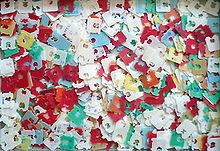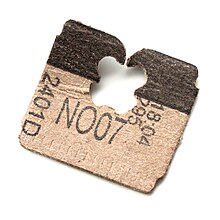Bread clip

Abread clipis a device that is used to hold plastic bags closed, such as those in whichsliced breadis commonly packaged. They are also commonly calledbread tags,bread tabs,bread ties,bread buckles,orbread-bag clips.By sealing a bag more securely than tying or folding over its open end, and thus providing a nearlyhermetic seal,the contents are preserved longer.
Designs
[edit]Simple
[edit]
Most designs of bread clip consist of a single plastic part through which the neck of a plastic bag can be threaded. Because these clips are cheap, ubiquitous, and come in a variety of shapes and colors, some people collect them.[1]
Most bread clips are made from plastic #6polystyrene(PS),[2]butQuebec-based bread clip manufacturing company KLR Systems releasedrecyclable,cardboardbread clips in 2019,[3]which they later switched to producing in 2022.[4]
Such clips are also used forbagged milk.In theCanadian provincesofOntario,Quebec,New Brunswick,andNova Scotia,the most common package is 4 litres—three 1.33-litre sealed bags in a larger bag, which is closed with a clip and imprinted with the milk's expectedexpiration date.[citation needed]
Mechanical
[edit]A more complex bread clip design involves two articulated plastic parts mounted on a pivot with a spring between them to provide tension.
History
[edit]

The bread clip was invented byFloyd G. Paxtonand manufactured by the Kwik Lok Corporation, based inYakima, Washington[5]with manufacturing plants in Yakima andNew Haven, Indiana.Kwik Lok Corporation's clips are called "Kwik Lok closures".
Paxton was known for repeatedly telling the story about how he came up with the idea of the bread clip. As he told it, he was flying home on an airliner in 1952 and opened a bag of peanuts, whereupon he realized he had no way to reclose it. He rummaged through his wallet and found an expired credit card and hand-carved his first bag clip with a small pen knife. When a fruit packer, Pacific Fruit, wanted to replace rubber bands with a better bag closure for its new plastic bags, Paxton remembered his bag of peanuts. He hand-whittled another clip from a small sheet ofPlexiglas.With an order in hand for a million clips, Paxton designed a die-cut machine to produce the clips at high speed. Despite repeated attempts, Paxton never won a United States patent for the clips themselves. He did, however, win numerous patents for the high-speed "bag closing apparatus" that made the clips, inserted bread into the bags, and applied the clips to said bags.[citation needed]
The bread clip was developed in the early 1950s for a growing need to closeplastic bagson thepackagingline very efficiently. Manufacturers, using more and moreautomationin the manufacture and packaging of food, needed methods to raise production volumes and reduce costs. At the same time a hurried population of consumers wanted a fast and easy way to open and effectivelysealfood bags. The simple bread clip sufficed. In addition, re-closability became a selling point as smaller families and higher costs slowed consumption, leading to a potential for higher rates ofspoilage.
Kwik Lok continues to be the main manufacturer of bread clips with Schutte as their European competitor.[6]
Parody in media
[edit]The parody website horg.com, created by John Daniel, coined the termocclupanidsto describe bread clips,[A]and created a mockphylogenyof the different clip designs.[8]Researchers of occlupanids are called occlupanologists.[9]These terms have since been referenced in popular media.[10][9][11]
Health risks
[edit]Case studies in the medical literature document instances of inhalation and ingestion.[12][7]
References
[edit]Notes
[edit]Citations
[edit]- ^"Why Shani Nottingham turns plastic bread tags into art installations".Australian Broadcasting Corporation.
- ^"Because You Asked: Can Bread Clips be Recycled?".
- ^"KLR launches sustainable bag clip".8 August 2019.
- ^"Cardboard bread clips hitting grocery shelves after Quebec company ditches plastic".CBC News.13 May 2022.Retrieved9 May2024.
- ^Losanoff, Julian E.; Basson, Marc D. (September 2011)."Intestinal Obstruction by a Bread Clip".The American Surgeon.77(9): 177–178.doi:10.1177/000313481107700902.PMID21944599.ProQuest1443353273.Retrieved9 May2024.
- ^Grundhauser, Eric (25 May 2017)."Most of the World's Bread Clips Are Made by a Single Company".Atlas Obscura.Retrieved27 April2018.
- ^abLehmer, LM; Ragsdale, BD; Daniel, J; Hayashi, E; Kvalstad, R (September 2011)."Plastic bag clip discovered in partial colectomy accompanying proposal for phylogenic plastic bag clip classification".BMJ Case Reports.2011:bcr0220113869.doi:10.1136/bcr.02.2011.3869.PMC3176375.PMID22679182.
- ^Daniels, John."Holotypic Occlupanid Research Group".Archivedfrom the original on 2021-08-13.Retrieved2021-08-13.
- ^abKohlstedt, Kurt (2017-09-25)."Bagged & Tagged: An Introductory Field Guide to Plastic Bread Clips".99% Invisible.Archivedfrom the original on 2021-04-28.Retrieved2021-08-13.
- ^Boyle, Rhianna (2014-10-20)."Toward a Taxonomy of the Plasticae: Meeting The Holotypic Occlupanid Research Group".The Lifted Brow.Archivedfrom the original on 2021-08-13.Retrieved2021-08-13.
- ^"Critter of the Week: The occlupanid – a member of the phylum Plasticae".National Institute of Water and Atmospheric Research.2016-05-19.Archivedfrom the original on 2021-08-13.Retrieved2021-08-13.
- ^Karro, R; Goussard, P; Loock, J; Gie, R (May 2015)."The simple bread tag - a menace to society?".South African Medical Journal.105(5): 342–44.doi:10.7196/SAMJ.8996(inactive 2024-11-10).hdl:10019.1/99354.PMID26242660.
{{cite journal}}:CS1 maint: DOI inactive as of November 2024 (link)

